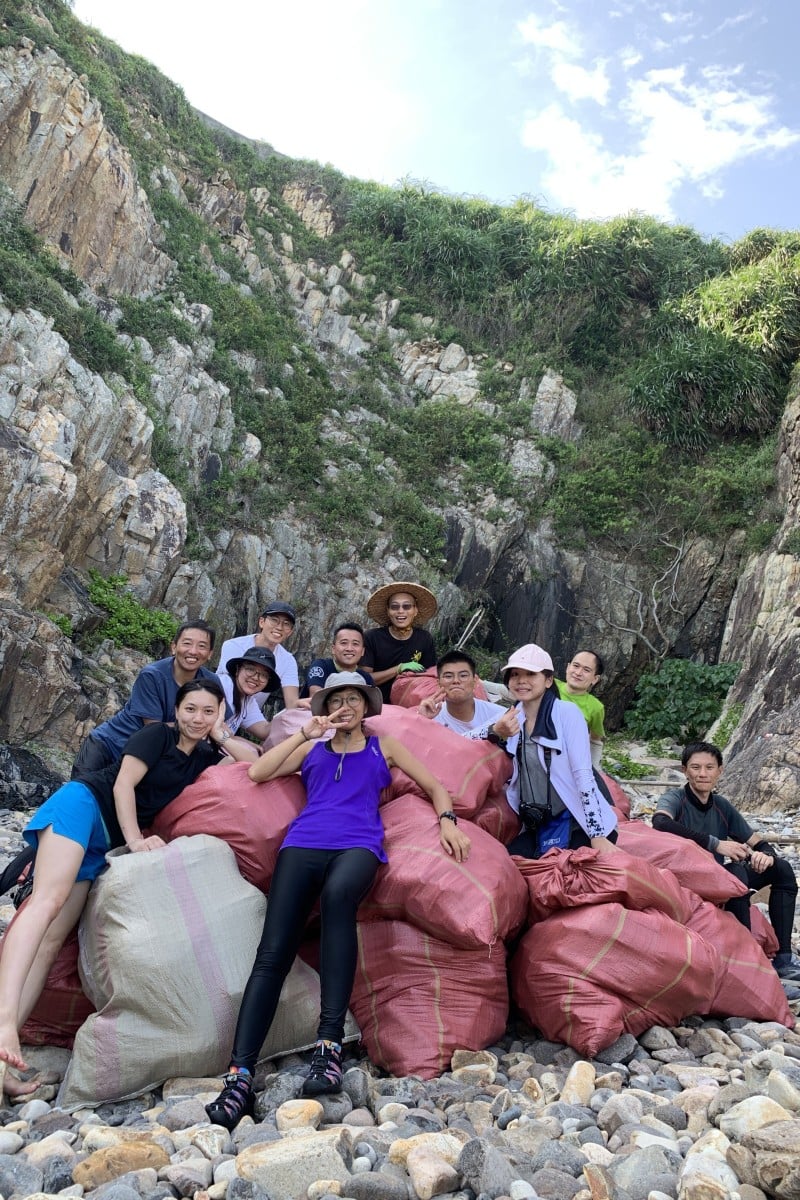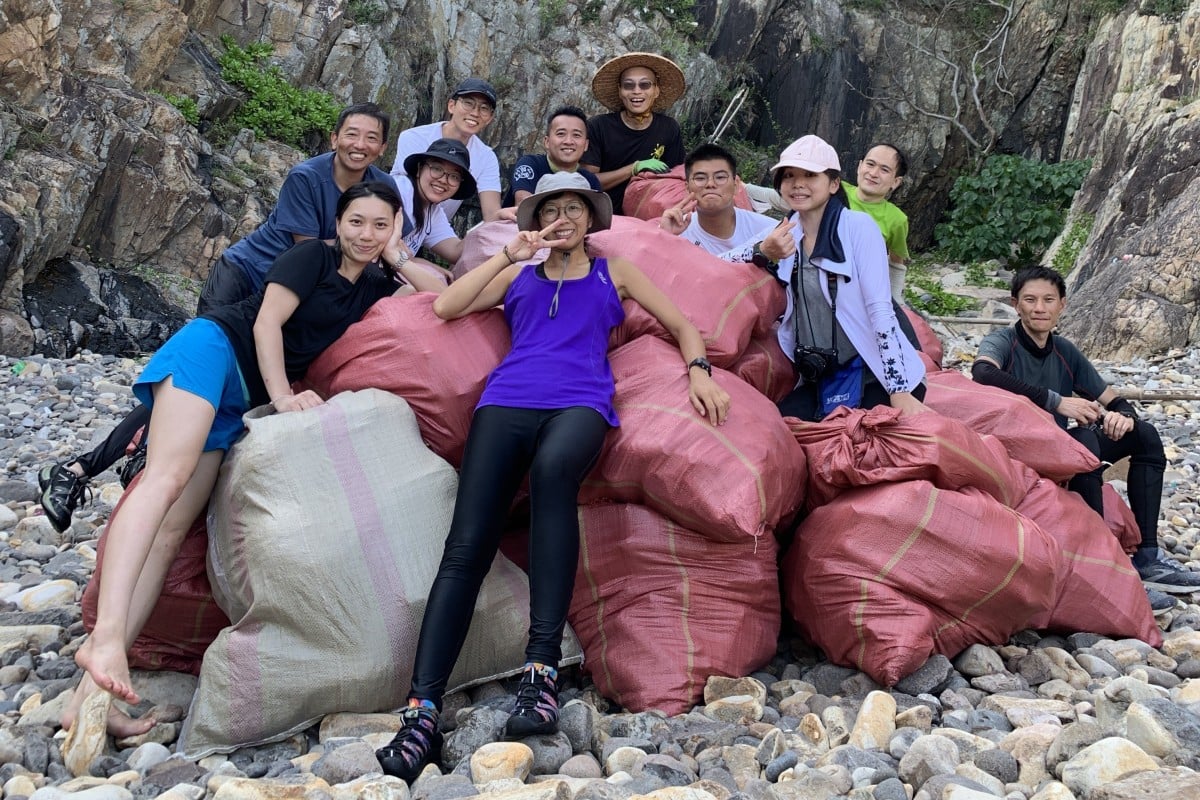
- CraSea Cleanupper uses Google Maps satellite view to find hidden spots where rubbish has accumulated; in 2023 alone they collected 4,678kg of litter
- Members hope the city’s latest waste reduction measures can lessen the flow of garbage and plastic into the ocean
 CraSea Cleanupper volunteers target remote areas which are less likely to be cleaned by other people. Photo: Handout
CraSea Cleanupper volunteers target remote areas which are less likely to be cleaned by other people. Photo: HandoutTiny vintage toys, colourful fishing floats, shoes of all sizes, and drinking straws dotted with bite marks from fish – these are just a few of the everyday items that made their way onto a remote shoreline on Lamma Island.
In 30 minutes, six volunteers, armed with gloves and tongs, filled three garbage bags with 8kg of litter.
This event in April is part of the weekly routine for beach clean-up group, CraSea Cleanupper, founded in 2021 to address waste in Hong Kong’s secluded waters.
“We target remote areas and places with excessive amounts of rubbish. While beaches near residential areas may have more litter, there are also more people available to clean up,” said the group’s founder, Yeung Ting.
‘Still a lot of work’: climate activist Melati Wijsen’s message to Hong Kong
CraSea Cleanupper has 20 members who come from diverse backgrounds but share the same concerns about the environment. So far, they have organised more than 100 clean-up operations. In 2023 alone, they collected 4,678kg of rubbish.
“Anything imaginable ... can appear on the beach if people have used those items in their daily lives,” said Yeung, who is a freelance environmental educator and has been cleaning the city’s beaches for more than a decade.
“Initially, I was astonished at finding fridges and washing machines on the beaches, but now I’m accustomed to these unexpected objects.”
The most common items they come across are plastic bottles: last year, they collected 38,333 bottles weighing 1,294kg. Styrofoam came in second place, amounting to an impressive 1.5 tonnes.
All the litter collected is sent to the landfill. “Waste that has been soaked in seawater poses a risk of bacterial contamination and is not suitable for recycling,” Yeung said.
Over the years, Yeung has observed how the city’s environment is increasingly overwhelmed by waste.
“People have become more accustomed to embracing a disposable lifestyle. The pace that waste is generated outstrips the speed at which we can clean it up,” she said.
How does rubbish get into the ocean?
Most of the waste that ends up in Hong Kong’s waters is generated locally. This can be the result of improper waste management: sometimes, litter is discharged through sewers, or it falls out while being transported to landfills.
Plastic waste is especially problematic as it can take hundreds of years to decompose, while leaving behind microplastics that have been linked to health issues.
Last Monday, the city’s “disposable lifestyle” was met with a ban on single-use plastic.
“Nobody wants to prohibit a convenient option, [but] this policy reflects that our plastic usage has reached an unsustainable level,” Yeung stressed. “Plastic production is cost-effective, but it has significant costs on our environment.”
How customers, eateries are reacting to Hong Kong single-use plastics ban
With the city’s three existing landfills expected to reach capacity in the coming years, the government has introduced a series of measures to reduce waste.
In a survey conducted by the New Youth Forum this month, only 13 per cent of the 1,032 respondents expressed support for the city’s waste-charging scheme, slated to take effect in August.
Some participants raised concerns about the insufficiency of Hong Kong’s recycling facilities, and many felt the scheme needed more public input.
But Yeung believed these initiatives could help build a more eco-friendly society: “The plastic restriction is the best way to deal with plastic waste pollution.”
“While paper tableware may not be the best substitute ... people should develop the habit of bringing their tableware or using other decomposable utensils.”
The environmentalist emphasised the need for waste reduction: “Only by reducing the waste we generate can we truly diminish the chances of these items ending up in the ocean ... [or] exacerbating the strain on our landfills.”
“Recycling is not an antidote as not all recycled items will be effectively utilised,” she added.
Take back control of our environment
CraSea Cleanupper first began as Yeung’s project on pollution. She gathered volunteers to clean up the city’s beaches and collect data on waste. Once, in Mui Wo, they collected more than 1,400 plastic bottles.
Eventually, they formed a group and began conducting regular clean-ups on Thursdays to avoid crowds.
Before each meet-up, they examine the satellite view on Google Maps to uncover spots with rubbish.
“If you notice coastlines with many white specks, those are likely styrofoam, which indicates potential garbage accumulation,” Yeung said, adding that they considered factors such as ocean currents and weather conditions.
Hong Kong drains pour billions of pieces of microplastics into the sea every day
Given the massive amounts of waste they collect, the group notifies the relevant government departments in advance to ensure proper disposal of the garbage bags.
Aside from their beach clean-ups, the group also organises exhibitions and booths to educate the public about the waste polluting our oceans.
“These kinds of events aim to show people the diversity of ocean waste and how they are connected and relevant to our daily life,” said Kwong Chi-chung, 44, an environmental educator and CraSea Cleanupper member.
“When we discard rubbish, it does not simply vanish into thin air. It may go somewhere beyond our sight, but it still exists somewhere on our planet.”
Reflecting on how his eco-friendly lifestyle started after a beach clean-up in 2017, Kwong noted that being environmentally conscious is a choice that individuals should try incorporating into their lives.
“Schoolchildren carry their own water bottles and hand towels. But it is puzzling why we grow out of these healthy habits and instead embrace a disposable lifestyle promoted by capitalism,” he said.
“There are many things we are told by society that we need, but by saying no to a straw or [excess] clothes, I can rethink my life and find out the things I truly need.”
accustomed 習慣
familiar with something
antidote 解藥
something that prevents unwanted effects
exacerbating 加重
to increase the severity
outstrips 超過
to outdo; surpass
secluded 偏僻
sheltered or screened from general activity
slated 預定
planned or scheduled
strain 壓力
a force that puts pressure on something
